Discover 11 hidden attractions, cool sights, and unusual things to do in Romney (United States). Don't miss out on these must-see attractions: Literary Hall, Indian Mound Cemetery, and Fort Mill Ridge Civil War Trenches. Also, be sure to include Hampshire County Courthouse in your itinerary.
Below, you can find the list of the most amazing places you should visit in Romney (West Virginia).
Table of Contents
Literary Hall
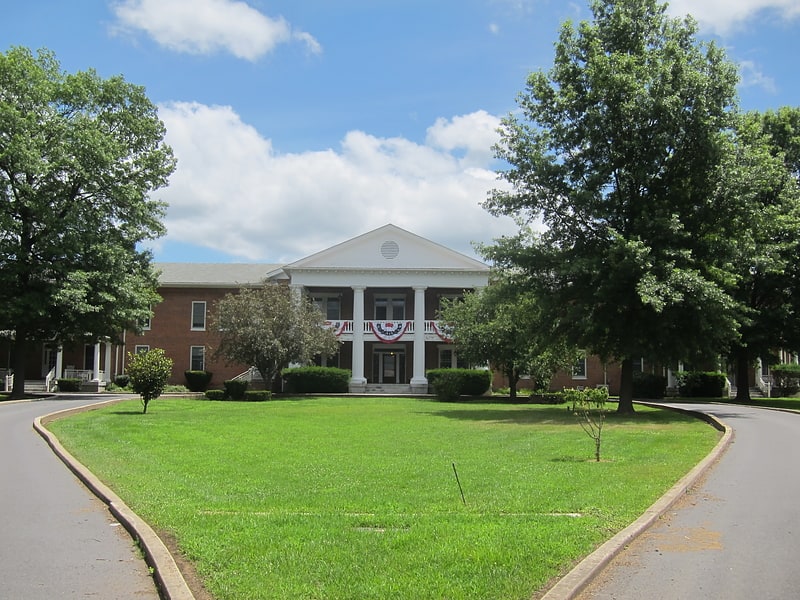
Library in Romney, West Virginia. Literary Hall is a mid-19th-century brick library, building and museum located in Romney, a city in the U.S. state of West Virginia. It is located at the intersection of North High Street and West Main Street. Literary Hall was constructed between 1869 and 1870 by the Romney Literary Society.
Founded in 1819, the Romney Literary Society was the first literary organization of its kind in the present-day state of West Virginia, and one of the first in the United States. In 1846, the society constructed a building which housed the Romney Classical Institute and its library. The Romney Literary Society and the Romney Classical Institute both flourished and continued to grow in importance and influence until the onset of the American Civil War in 1861.
During the war, the contents of the society's library were plundered by Union Army forces, and many of its 3,000 volumes were either scattered or destroyed. After a reorganization in 1869, the society commenced construction of the present Literary Hall in downtown Romney. It transferred ownership of its Romney Classical Institute campus to the West Virginia Schools for the Deaf and Blind in 1870 and in that year completed Literary Hall, where the society reconstituted its library collection and revived its literary activities.
The Romney Literary Society's last meeting was held at Literary Hall in 1886. From that point to 1973 the building was used as a meeting space by the Clinton Lodge of Ancient Free and Accepted Masons and the Order of the Eastern Star. In 1973, the building was purchased by prominent Romney lawyer Ralph Haines, who used it as a law office and museum. From 1937 to the early 1940s the building also housed a community library. Literary Hall was listed on the National Register of Historic Places on May 29, 1979.[1]
Indian Mound Cemetery
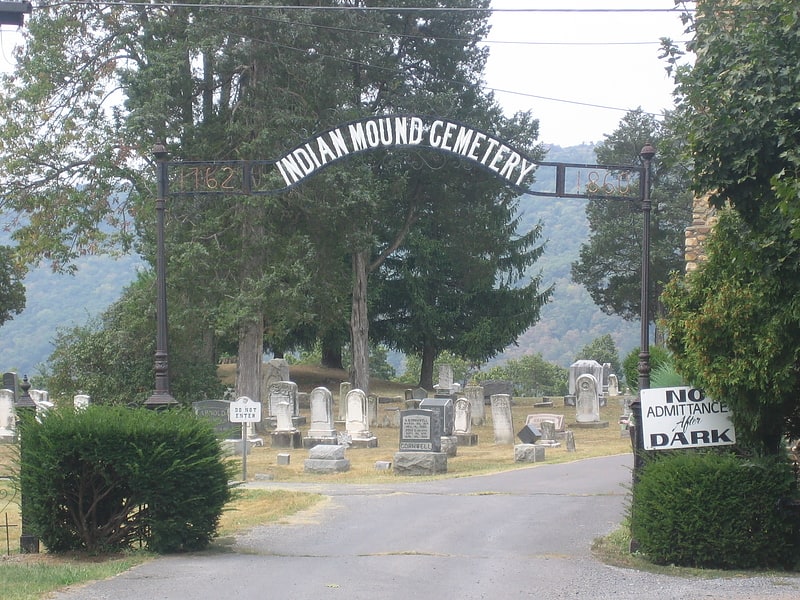
Cemetery in Romney, West Virginia. Indian Mound Cemetery is a cemetery located along the Northwestern Turnpike on a promontory of the "Yellow Banks" overlooking the South Branch Potomac River and Mill Creek Mountain in Romney, West Virginia, United States. The cemetery is centered on a Hopewellian mound, known as the Romney Indian Mound. Indian Mound Cemetery is also the site of Fort Pearsall, the Confederate Memorial, Parsons Bell Tower, and reinterments from Romney's Old Presbyterian Cemetery. The cemetery is currently owned and maintained by the Indian Mound Cemetery Association, Inc.
Indian Mound Cemetery is the burial site of two governors of West Virginia, a United States House Representative, a United States Secretary of the Army, an owner of the Washington Redskins, and descendants of the family of George Washington.
Days before the 150th anniversary of the Confederate Monument's dedication was to be observed, it was vandalized. The vandalism read "reparations now", and was done using black spray paint. The damage to the monument has since been repaired.[2]
Fort Mill Ridge Civil War Trenches
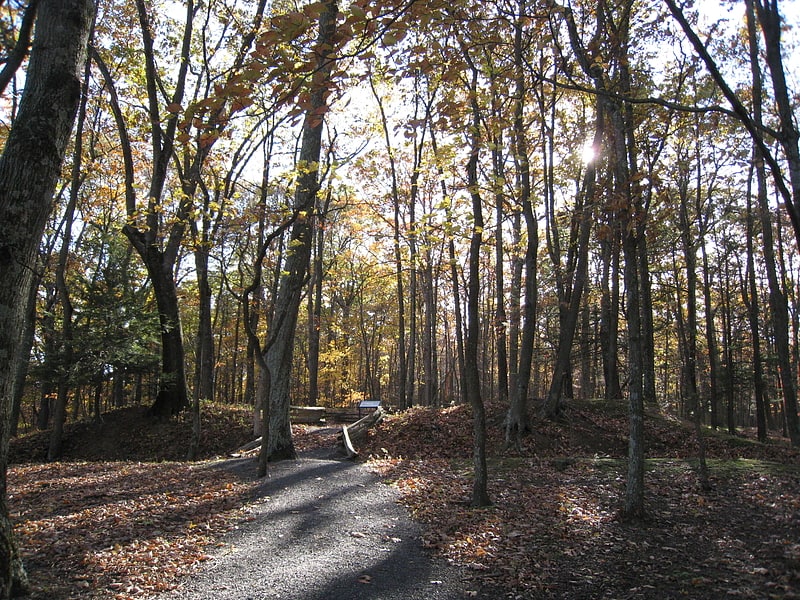
The Fort Mill Ridge Civil War Trenches are battle trenches in West Virginia that were originally dug between 1861 and 1862 to be later used in 1863 for the civil war. These trenches lined with chestnut logs by the Confederate artillery during the American Civil War to defend the approaches to Romney on the Northwestern Turnpike and the South Branch Potomac River. The trenches were then refurbished between March and June 1863 by the 54th Pennsylvania Infantry and the 1st West Virginia Infantry. When Colonel Jacob M. Campbell garrisoned Union forces at Romney, camps were set up at nearby at Mechanicsburg Gap. The Confederates might have created these trenches but all throughout the war the Union had control of these trenches.
The Fort Mill Ridge trenches are believed to be the best preserved battle trenches dating from the Civil War in existence. The trenches are located three miles southwest of Romney adjacent to the Fort Mill Ridge Wildlife Management Area off of the Northwestern Turnpike (U.S. Route 50/West Virginia Route 28).
A Civil War museum relating to the construction and use of the Fort Mill Ridge trenches is located within the Taggart Hall Civil War Museum & Visitors Center on the corner of High Street and Gravel Lane in downtown Romney.
This place is significant not only because of battle that was being taken place but for the military and engineering. The engineering style the Confederates used is an excellent example of a rammed earth fortification" to protect the transportation routes as well. Also, this brought a new age to wars and a new fighting style of fighting in trenches rather than an open field. It provided more protection and defense than the offensive strategy of fighting. The defensive method was used so the transports can pass by safely.
It was listed on the National Register of Historic Places in 2014.[3]
Address: Fort Mill Ridge Road, Romney
Hampshire County Courthouse
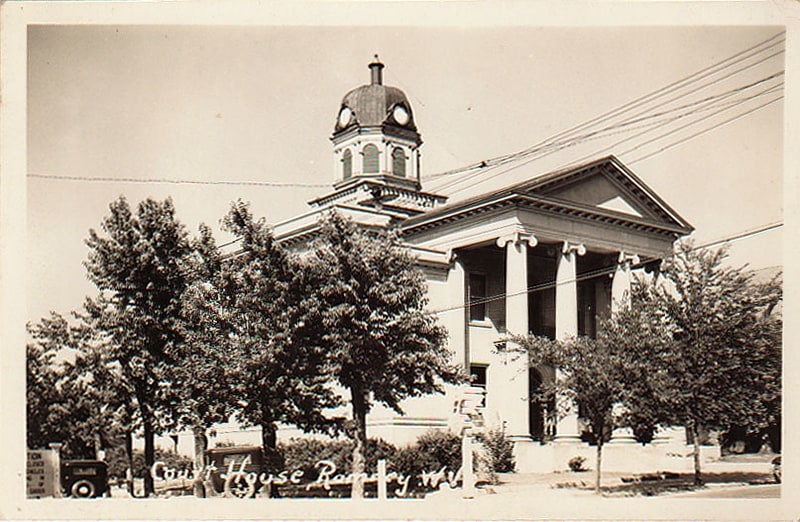
Edifice. The Hampshire County Courthouse is a Neoclassical edifice in the center of downtown Romney, county seat of Hampshire County, West Virginia. The present building was constructed in 1922 to replace the previous 1833 Neoclassical courthouse that had been destroyed by fire in 1921. The original bell from the 1833 courthouse hangs in the domed bell tower.[4]
Confederate Memorial

The Confederate Memorial at Indian Mound Cemetery in Romney, West Virginia, commemorates residents of Hampshire County who died during the American Civil War while fighting for the Confederate States of America. It was sponsored by the Confederate Memorial Association, which formally dedicated the monument on September 26, 1867. The town of Romney has claimed that this is the first memorial structure erected to memorialize the Confederate dead in the United States and that the town performed the nation's first public decoration of Confederate graves on June 1, 1866.
The idea to memorialize the Confederate war dead of Hampshire County was first discussed in the spring of 1866. Following the decoration of the graves that summer, the Confederate Memorial Association engaged in fundraising for construction of the memorial, and by 1867 the necessary funds were raised. The inscription The Daughters of Old Hampshire Erect This Tribute of Affection to Her Heroic Sons Who Fell in Defence of Southern Rights was selected, and the contract for the memorial's construction was awarded to the Gaddes Brothers firm of Baltimore. The memorial's components were delivered to Indian Mound Cemetery on September 14, 1867, and the memorial was dedicated on September 26 of that year. The construction of the Confederate Memorial marked the beginning of an era of post-war revitalization for Hampshire County following the American Civil War.
The memorial comprises a base with obelisk and capstone, standing on a raised mound. The list of 125 names engraved on the monument includes four captains, seven lieutenants (one of which was a chaplain), three sergeants, and 119 privates. The memorial underwent a restoration in 1984, and is decorated annually with a handmade evergreen garland and wreath on Hampshire County Confederate Memorial Day.[5]
Wilson-Wodrow-Mytinger House

Building in Romney, West Virginia. The Wilson-Wodrow-Mytinger House is a complex of three structures, built between the 1740s and 1780s, in Romney, West Virginia. The clerk's office, dating from the 1780s, is the oldest surviving public office building in West Virginia. The kitchen building is the oldest remaining component of the Wilson-Wodrow-Mytinger House and the oldest building in Romney. Throughout its history, the Wilson-Wodrow-Mytinger House has been known as the Andrew Wodrow House, the Mytinger Family Home, and the Mytinger House.
The earliest person recorded residing on Lot Number 48 in Romney was Hugh Murphy. In 1763, Colonel George William Wilson received a patent to Lot Number 48 from Thomas Fairfax, 6th Lord Fairfax of Cameron, to purchase the lot from Murphy. Wilson served in the Hampshire County militia as a major during the French and Indian War. He relocated to Pennsylvania, and in 1770, George Washington spent the night in a log cabin on the northeastern corner of Lot Number 48. Andrew Wodrow arrived in Hampshire County near or after the end of the American Revolutionary War. In 1782, Wodrow became clerk of court for Hampshire County. He completed the clerk’s office building in the 1780s, and the complex assumed its current configuration by 1790.
Wodrow served as Clerk of Court for Hampshire County until his death in 1814, after which ownership passed to Wodrow's son-in-law, John McDowell; a Dr. McClinoch; and the Mytinger family, who retained the property for about 100 years. Manning H. Williams purchased the house and restored it in 1962. Dr. Herbert P. Stelling purchased the Wilson-Wodrow-Mytinger House in 1973, and it opened as a museum and an arts and handicrafts shop known as Colonial Craftsmen. While under the Stelling family's ownership, the house was listed on the National Register of Historic Places in 1977. Its current owners, Old Hampshire Ltd. purchased the Wilson-Wodrow-Mytinger House in 1985.[6]
Taggart Hall
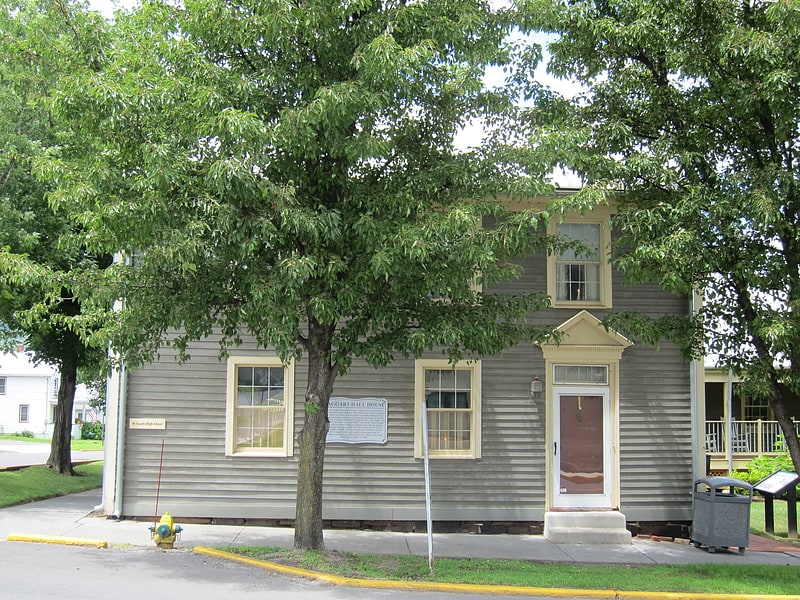
Museum in Hampshire County. Taggart Hall is a late 18th-century residence that currently houses the Fort Mill Ridge Foundation and its Fort Mill Ridge Civil War Trenches museum, the Hampshire County Visitors Bureau, and the Hampshire County Chamber of Commerce. It is located in Romney, West Virginia, at 91 South High Street. Nextdoor to Taggart Hall on Gravel Lane stands Romney's oldest structure, the Wilson-Wodrow-Mytinger House.
Taggart Hall was constructed in the 1790s by Frances Taggart (Tygart), a Quaker, on a lot at the corner of High Street and Gravel Lane laid out in the original Romney survey conducted in 1762 on behalf of Thomas Fairfax, 6th Lord Fairfax of Cameron. Taggart Hall was originally built as a clapboard "half-house". The original eighteenth-century structure has been expanded to accommodate the Fort Mill Ridge Foundation, the Hampshire County Visitors Bureau, and the Hampshire County Chamber of Commerce.[7]
Address: Romney, 91 South High Street
Wappocomo
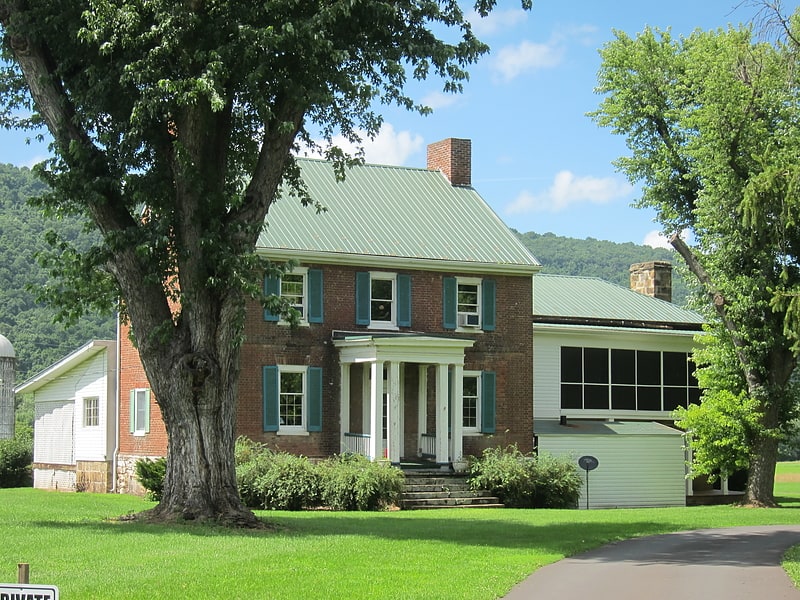
Mansion in Hampshire County, West Virginia. Wappocomo is a late 18th-century Georgian mansion and farm overlooking the South Branch Potomac River north of Romney, Hampshire County, West Virginia, USA. It is located along Cumberland Road and the South Branch Valley Railroad.
The original section of the mansion at Wappocomo was built in 1774 by Nicholas Casey (1745–1833), using bricks that had been used as ballast to stabilize ships loading tobacco in the James River. The Wappocomo property had been a part of the South Branch Survey of Thomas Fairfax, 6th Lord Fairfax of Cameron's Northern Neck Proprietary. The Parsons family, prominent in Virginia and West Virginia politics in the 18th and 19th centuries, acquired Wappocomo and continue to maintain ownership of the property into the 21st century.
Wappocomo was involved in two slavery-related disputes that caused friction between the governments of Pennsylvania and Virginia. In 1788, Nicholas Casey purchased a freed slave by the name of John, who had been kidnapped in Pennsylvania and returned into slavery in Virginia. Pennsylvania Governor Thomas Mifflin demanded that the Governor of Virginia punish the three Virginia residents responsible for the abduction and re-enslavement of a freedman, however, Virginia's governor cited the absence of such a clause in the United States Constitution. In August 1855, a fugitive slave named Jacob Green escaped from Wappocomo with several other slaves to Pennsylvania. Col. Isaac Parsons (1814–62) and his nephews went north to pursue the escapees, resulting in the arrest of his nephew, James "Zip" Parsons III (1831–93). Parsons' trial caused a further dispute between the states of Virginia and Pennsylvania over the latter's refusal to execute the Fugitive Slave Act of 1850.
The mansion at Wappocomo is unique among the historic residences along the South Branch Potomac River, in that its formal façade faces toward the road and the western flanks of South Branch Mountain rather than toward the river. The original 1774 portion of the mansion is a square two-story Georgian-style structure, an architectural style prevalent in Virginia at the time of Wappocomo's construction. The bricks used to build the 1774 structure were manufactured in England, and used as ballast to stabilize ships loading tobacco in the James River. The interior of the 1774 structure contains a grand stairway in the center hall and all the original handmade woodworking. A stone addition to the mansion with two stories of deep verandas was completed in 1861. The principal passenger depot for the Potomac Eagle Scenic Railroad, Wappocomo Station, is located at the farm.[8]
Valley View

Farm in Hampshire County, West Virginia. Valley View is a mid-19th-century Greek Revival residence and farm overlooking the South Branch Potomac River northwest of Romney, West Virginia. The house is atop a promontory where Depot Valley joins the South Branch Potomac River valley.
The Valley View property was part of the South Branch Survey of the Northern Neck Proprietary, a large tract that was inherited by Thomas Fairfax, 6th Lord Fairfax of Cameron, in 1719. It was settled by John Collins and his family in 1749, and acquired by the Parsons family before 1772. The Valley View house was built by James Parsons Jr. in 1855. After the Civil War, Parsons' widow sold the farm to Charles Harmison. His wife, Elizabeth Harmison, inspired by her childhood Virginia home, Western View, and the scenic South Branch Potomac River views, named the farm Valley View. The most recent of a series of owners, the Mayhew family, bought the property in 1979. Valley View's current proprietors, Robert and Kim Mayhew, have restored the historic residence and grounds.
The house at Valley View is a two-story brick structure with a rectangular architectural plan. The front entrance is covered by a small portico, topped with a pediment supported by wooden Doric columns. The rear of the house, with a two-story wood porch stretching across it, faces the South Branch Potomac River valley and Mill Creek Mountain. Each of the original eight large rooms of the 1855 structure contains a fireplace framed by a wooden mantelpiece with classical elements. The original windows, wooden trim, and materials in the main section of the house are intact. The house was listed on the National Register of Historic Places in 2012 as a locally significant example of Greek Revival architecture.[9]
Washington Place
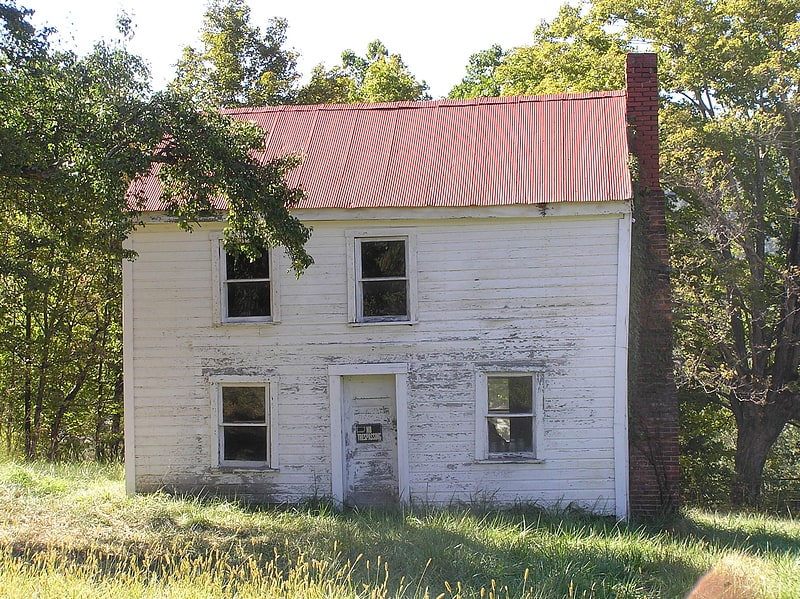
Home in Hampshire County. Washington Place is one of the first homes built by freed slaves after the Emancipation Proclamation of 1863 in Hampshire County, West Virginia, United States. Washington Place was built by William and Annie Washington in north Romney between 1863 and 1874 on land given to Annie by her former owner, Susan Blue Parsons of Wappocomo plantation. William Washington later acquired other properties on the hills north of Romney along West Virginia Route 28 and became the first African-American land developer in the state of West Virginia. One of his subdivisions is the "Blacks Hill" neighborhood of Romney, adjacent to the Washington Place homestead. Washington Place was bought and restored by Ralph W. Haines, a local attorney and historic preservationist.[10]
Address: Romney, Cumberland Road & Mitchell Street
Old Methodist District Parsonage
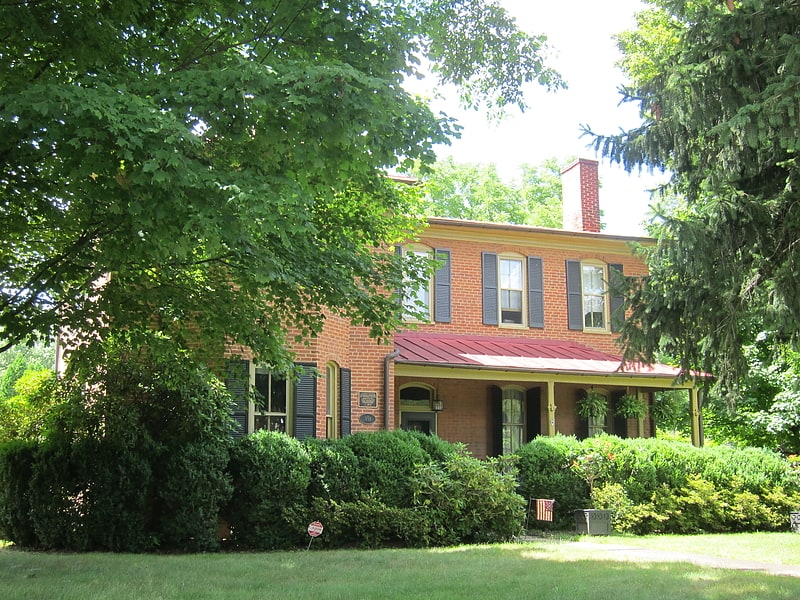
Church in Romney, West Virginia. The Old Methodist District Parsonage is a 19th-century Italianate residence in Romney, West Virginia, United States. It is a two-story brick dwelling constructed between 1868 and 1882 to serve as the district parsonage for the area's Methodist churches. After it fell out of use by the church, the eight-room residence was purchased and restored by the Long family and currently features 18th and 19th century furnishings and folk art. The Old Parsonage was listed on the National Register of Historic Places in 2005.[11]